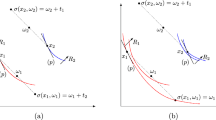Abstract
We study allocation problems in which a costly task is to be assigned and money transfers are used to achieve fairness among agents. We consider a series of fairness notions (k-fairness for \({k \in \{1,\dots,n\}}\) where n is the number of agents) of decreasing restrictiveness that are based on Rawls’ maximin equity criterion and impose welfare lower bounds. These fairness notions were introduced by Porter et al. (J Econ Theory 118:209–228, 2004) who also introduced two classes of Groves mechanisms that are 1-fair and 3-fair, respectively, and generate deficits that are bounded above. We show that these classes are the largest such classes of Groves mechanisms. We generalize these mechanisms for each \({k \in \{2,\dots,n\}}\) and show that the corresponding mechanisms generate the smallest deficit for each economy among all k-fair Groves mechanisms.
Similar content being viewed by others
References
Alkan A, Demange G, Gale D (1991) Fair allocation of indivisible goods and criteria of justice. Econometrica 59: 1023–1039
Clarke EH (1971) Multi-part pricing of public goods. Publ Choice 11: 17–33
Foley D (1967) Resource allocation and public sector. Yale Econ Essays 7: 45–98
Green J, Laffont JJ (1979) Incentives in public decision making. North-Holland, Amsterdam
Holmström B (1979) Groves’ scheme on restricted domains. Econometrica 47: 1137–1144
Pápai S (2003) Groves sealed bid auctions of heterogeneous objects with fair prices. Soc Choice Welf 20: 371–385
Pazner A, Schmeidler D (1978) Egalitarian equivalent allocations: a new concept of economic equity. Q J Econ 92: 671–687
Porter R, Shoham Y, Tennenholtz M (2004) Fair imposition. J Econ Theory 118: 209–228
Rawls J (1971) A theory of justice. Harvard University Press, Cambridge
Schummer J (2000) Eliciting preferences to assign positions and compensation. Games Econ Behav 30: 293–318
Tadenuma K, Thomson W (1991) No-envy and consistency in economies with indivisible goods. Econometrica 59: 1755–1767
Thomson W (2005) Strategy-proof allocation rules on economic domains. Unpublished manuscript, Department of Economics, University of Rochester
Walker M (1980) On the nonexistence of a dominant strategy mechanism for making optimal public decisions. Econometrica 48: 1521–1540
Yengin D (2006) The super-fair Groves mechanisms and fair compensation in government requisitions and eminent domain proceedings. Unpublished manuscript, School of Economics, University of Adelaide
Yengin D (2007) Groves mechanisms and welfare bounds in a variable population setting. Unpublished manuscript, School of Economics, University of Adelaide
Author information
Authors and Affiliations
Corresponding author
Additional information
The first draft of this paper was written while we were Ph.D. students at the University of Rochester. We are grateful to William Thomson for his guidance and advice. We also thank two referees and the associate editor for their comments.
Rights and permissions
About this article
Cite this article
Atlamaz, M., Yengin, D. Fair Groves mechanisms. Soc Choice Welfare 31, 573–587 (2008). https://doi.org/10.1007/s00355-008-0297-9
Received:
Accepted:
Published:
Issue Date:
DOI: https://doi.org/10.1007/s00355-008-0297-9




